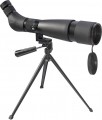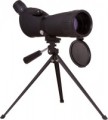Field of view 1 km away
The field of view of the telescope at a distance of 1 km to the objects under consideration, the so-called "linear field of view". In fact, this is the width (diameter) of the space that falls into the field of view when observed from a distance of 1 km.
This parameter is widely used in the characteristics of telescopes along with the angular field of view (see below): the linear field of view data is more visual and closer to practice, it allows you to evaluate the capabilities of a telescope without resorting to special calculations.
For models of variable magnification (the majority of them), the linear field of view is indicated in the form of two numbers — for the minimum and for the maximum magnification.
Min. focus distance
The smallest distance to the object under consideration at which the telescope is able to fully focus on it — that is, the minimum distance at which the image in the eyepiece will remain clear.
Spotting scopes were originally designed for viewing distant objects, so focus problems can occur if the distance is too small. Thus, manufacturers indicate this parameter in the characteristics. However, even in the most powerful and "long-range" models, the minimum focus distance is about 25 m — at this distance, the naked eye is often enough. Therefore, you should pay attention to this parameter only in cases where the ability to work normally close is of fundamental importance — for example, if the pipe is used at a shooting range, where the distance to the targets can be different, including pretty small.
Focus
A method of focus provided in the design of a telescope.
This parameter is indicated by which control element is responsible for focus:
a screw on the body, a ring on the
body or
eyepiece, etc. However, it cannot be said that any method has fundamental advantages or disadvantages. By themselves, they are all quite functional, and the choice of the manufacturer is based primarily on which option is best suited specifically for this device. So paying attention to this parameter makes sense, first of all, for those who have certain preferences (for example, they are used to the ring on the eyepiece) and do not want to use another method.
Anti reflective coating
The type of optics enlightenment provided in the telescope.
Enlightenment is called a special coating applied to the surface of the lens. This coating is designed to reduce light loss at the air-glass interface. Such losses inevitably arise due to the reflection of light, and the anti-reflective coating "turns" the reflected rays back, thus increasing the light transmission of the lens. In addition, this function reduces the amount of glare on objects visible through a telescope.
Enlightenment types can be:
—
Single layer. This marking means that one or more surfaces of the lenses (but not all) have been coated with a single layer of anti-reflection coating. This is inexpensive and can be used even in entry-level optical devices. On the other hand, it filters out a certain spectrum of light, which distorts the colour reproduction in the visible image — sometimes quite noticeably. In addition, in this case, on some surfaces of the lenses there is no coating at all, which inevitably leads to the appearance of glare in the field of view. Thus, single-layer enlightenment is the simplest variety and is used extremely rarely, mainly in low-cost models.
—
Full single layer. A variation of the single-layer coating described above, in which an anti-reflection coating is present on all lens surfaces (at each air-glass interface). Although this option is also characterized
...by colour distortion, it is devoid of another, the most key drawback of “incomplete” enlightenments — glare in the field of view. And the mentioned colour rendition distortion is most often not critical. With all this, full single-layer enlightenment is relatively inexpensive, due to which it is very popular in spyglasses of primary and primary-intermediate levels.
— Multi-layered. A type of coating in which a multilayer reflective coating is applied to one or more lens surfaces (but not all). The advantage of such a coating over a single-layer coating is that it evenly transmits almost the entire visible spectrum and does not create noticeable colour distortions. The absence of a coating on individual surfaces reduces the cost of the device (compared to full multilayer coating), but it is impossible to completely get rid of glare in such a system.
— Full multilayer. The most advanced and effective of today's types of coating: a multi-layer coating is applied to all lens surfaces. Thus, high brightness and clarity of the “picture” are achieved, with natural colour reproduction and the absence of glare. The disadvantage of this classic option is the high cost; accordingly, full multilayer enlightenment is typical mainly for high-end telescopes.Prism material
The material used for prisms mounted in a telescope (see "Type of Prisms").
—
BK7. A variety of borosilicate optical glass (crown), a relatively inexpensive and at the same time quite functional material that provides, although not outstanding, but quite acceptable image quality. It is used in models of initial and intermediate levels.
—
BaK4. Barium optical glass, which is noticeably superior to BK7 in terms of brightness and image clarity, but also more expensive. Found mainly in premium spyglasses.
Swivel body
The presence
of a swivel body in the design of the telescope.
This term usually means the ability to rotate the back of the device, with the eyepiece, relative to the lens. This feature is found mainly in models with a 45° eyepiece (see “Eyepiece position”), as well as in “straight” tubes with Porro prisms, in which the eyepiece axis is offset relative to the lens axis. In both cases, the swivel body allows you to choose the most advantageous position of the lens, depending on the situation. For example, for observations of the sky, it is most convenient to hold a curved body in a standard position, with the eyepiece up; and by turning the “peephole” down, you can conveniently observe wildlife from a pit or other shelter, hiding in it entirely and exposing only the pipe lens to the outside. Similarly, turning a straight eyepiece can be useful to adjust the scope to the situation.
Body
Material and general construction of the telescope housing.
Most modern models use rubberized cases, in which a solid base (metal or durable polycarbonate) is covered with rubber. This provides not only strength, but also increased shock resistance — even in the case when shock resistance as such (see above) is not claimed in the characteristics. In premium models, magnesium alloy cases are found — it is characterized by high strength combined with low weight.
A separate category are the Galilean pipes (see above) — they are usually produced in a "retro" design and use appropriate materials, such as copper and a high-quality leatherette cover.

